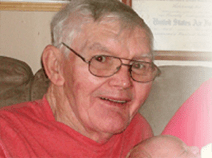The Challenge
Chester Radcliff is a family man who loves to hunt and fish with his grandchildren. He remained active despite waking up each morning since 1971 with severe pain in his neck and shoulder following a workplace accident.
The accident damaged the top two vertebrae in his neck (C1 and C2). At age 75, he was suddenly faced with the prospect of never playing with his grandchildren again.
"I never had a bit of fear, because I felt from the start I was in good hands." — Chester
Through the years, the damaged vertebrae had degenerated, creating a mass (odontoid pannus) that was pressing on Chester's spinal column at the brainstem. As a result, Chester was experiencing frequent falls and worsening weakness in his arms and legs. He was even beginning to have trouble swallowing, as well as double vision.
Neurologists in South Carolina told him that he wasn't a surgical candidate and nothing could be done to help him. Chester's prognosis was grim: within months he could be a quadriplegic.
Schedule an Appointment or Ask a Question
The Path to UPMC
By chance, Chester saw a television clip about surgery through the nose for brainstem tumors.
He and his wife, Nancy, turned to the internet to learn more, and discovered the Endoscopic Endonasal Approach being performed by UPMC surgeons.
Chester's doctors at home told him he wouldn't survive the surgery, but undeterred, Nancy sent Chester's medical records overnight to UPMC for a second opinion. A few days later, the Ratcliffs had the news they had hoped for.
"The doctor called and said, 'Mrs. Ratcliff, we can help your husband.' My response was to say, 'Thank God,' and we immediately scheduled Chester's surgery."
The Solution
The surgery was complex. First, the surgical team used the Endoscopic Endonasal Approach to remove the mass and the damaged vertebrae through the nose. Next, the team reconnected the skull to the spine with titanium rods and screws, using state-of-the-art CT-guided surgery. This stabilized Chester's spine for the first time in years.
For a man who had never faced surgery before, Chester was calm.
"I'm so happy I did this. I have eight grandkids and I don't want to be lying around in a wheelchair having them waiting on me. I never had a bit of fear, because I felt from the start I was in good hands."
The Results
Just four weeks after surgery, Chester, Nancy, and their daughter Elizabeth, were back in Pittsburgh for a follow-up visit. Chester was able to walk unassisted, no longer concerned that his legs might collapse at any moment. And, his vision was back to normal. The icing on the cake? The severe pain Chester had lived with since 1971 was completely gone.
Our patient stories profile a number of patients who have had minimally invasive brain surgery at UPMC. Although everyone's care experience is unique, we hope that sharing these stories will help other prospective patients and their families better understand these procedures and their potential benefits.
Chester's treatment and results may not be representative of all similar cases.

















